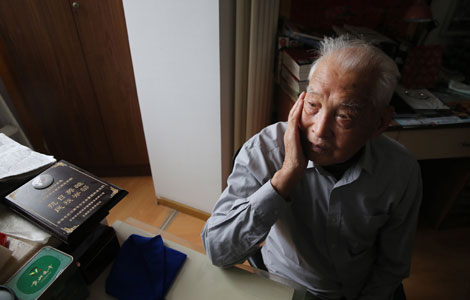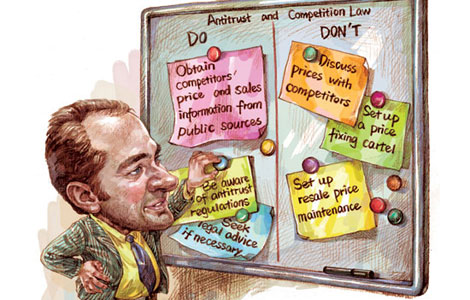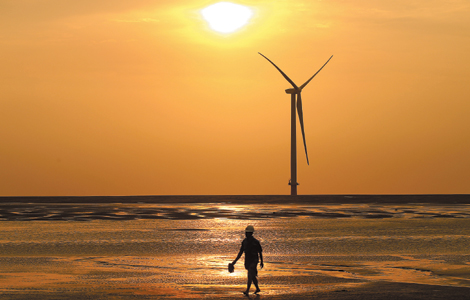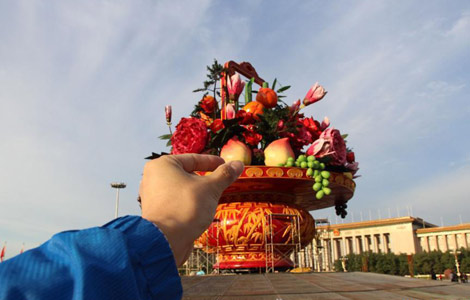China's first limo and Chinese leaders
Updated: 2013-09-26 02:11
By Cheng Lu, Liu Xin (Consulate-General of the People's Republic of China in New York)
|
|||||||||||
What sedans did Chairman Mao Zedong choose for parade and daily use? Some of them could be found in a private classic car museum in Beijing, capital of China.
Located 80 kilometers north of the city, the Beijing Classic Car Museum has 200-plus old limousines comprising Chinese and foreign brands like Hongqi (Red Flag), Ford, Dodge, Desoto, Mercedes-Benz and Volga.
Among them are 36 national sedan Hongqi vehicles and they are Luo Wenyou's favorites. He is the owner of the museum.
"Some of them were once used by Chairman Mao Zedong, Premier Zhou Enlai, and Marshal Nie Rongzhen," the 58-year-old Luo said.
In his eyes, "Hongqi represents China and Chinese car manufacturing the best."
In 1956, the Communist Party of China held its central political bureau meeting. Chairman Mao expressed his wish to be driven in a homemade car to the meeting.
At the time, China's auto industry was budding following the country's First Automobile Works (FAW) poised to break ground in 1953 in Changchun, capital city of northeast Jilin Province.
"'Live up to Mao's expectations, make a desirable car dedicated to him' had become a popular cry since then," Luo told.
In 1958, the first Hongqi sedan was produced by the FAW in response to Mao's wish.
Since its debut as parade sedan at Tian'anmen Square in 1959 during China's 10th National Day celebration, Hongqi's role has never been changed.
Chinese people have regarded the brand as the nation's pride for its links with party leaders and historical role in the country.
As told by Luo, Hongqi has been the state guest sedan replacing former Soviet Union's ZIS since 1964.
"In the sixties and seventies, being driven in a Hongqi car ranked alongside visiting Chairman Mao and staying at Diaoyutai State Guesthouse as one of the highest privileges for foreign dignitaries," Luo said.
In 1961, Indonesia's former President Sukarno paid a visit to China. During the welcome ceremony along the Tian'anmen Square, he stood on the Hongqi CA72 Cabriolet to salute people. But due to longtime standing, he felt tired and stepped onto the seat sitting on the back.
"It could help him look like standing," Luo said, "and Premier Zhou Enlai noticed what's happened."
Afterwards, Premier Zhou called for making a review car in which leaders and guests could either stand or sit.
One year later, the FAW developed a car that fulfilled Zhou's requirement. In the car, the reviewers could press a button and escalate the seat. Helped by this, they could be seen as if still standing.
Luo did not tell whether this kind of car has been used by other reviews after that.
But he collected a special car which witnessed Zhou's fight with bladder cancer.
"There is only a stretcher behind the driving cab," Luo introduced, "Premier Zhou could lay on the stretcher."
"The window was covered by curtain in order not to be recognized when it was driven among the fleet," Luo disclosed.
Luo Wenyou was born in the countryside in north China' s Hebei Province and lined his pocket by running a transport company, a karting site and an automobile repair shop since the age of 24.
He took fresh crack at collecting world classic cars from 1978 when private car was still a rarity in China's street, and has poured in tens of millions yuan into his "cause" up to now.
"I can' t exactly count how much money I have put in. The cars are priceless for me," said Luo.
His life was intimately entwined with Hongqi since 1998, when Louis Vuitton Classic, one of the world's largest free classic-car rallies, landed in China.
Luo drove the three rows of seats Hongqi CA770 in the rally from Dalian to Beijing as the only Chinese player.
He had almost 60 classic cars to choose from for the rally, including many high-performance world-level limousines.
"But I chose the Hongqi because a Chinese player should drive his own Chinese car in the game," he said.
As Luo's first Hongqi car, the V8-engined CA770 has a lesser-known legendary history. "Its previous owner is Nie Rongzhen."
Nie (1899-1992) was a prominent Chinese Communist military leader and one of 10 Marshals in the People's Liberation Army of China.
Luo said he forgot how many times he was moved to tears during the game. "Many witnesses shouted 'long live China, long live Hongqi'," he recalled.
Wherever he arrived, people lined the roads, cheering and taking photos with the Hongqi "in a display of respect and pride to Chinese-made vehicle".
"The rally changed me from a common classic car fan into a responsible lover of Chinese-made limousines, especially the Hongqi," Luo said.
"Since then, I have dreamt of letting more people know the history and value of them," he continued.
Luo sold his businesses and house after the rally and immersed himself in China' s classic car collection. His "craziness" used to anger his family, but nothing would stop him.
In 2005, he went to Beijing to build a classic car museum, only to find his love for ancient vehicles being cold-shouldered.
After spending eight million yuan, Luo' s private museum, a two-floor building of 3,000 square meters, finally opened in 2009. But he also changed from a multi-millionaire to a church mouse.
"It takes a certain strength to collect these cars, and an entirely different kind to let people know their existence and value," Luo told.
His initial purpose was to show people the history of Chinese classic cars as well as the nation. Unexpectedly, only a few school children and individual travelers visit the museum. It fails to make ends meet now.
"My sources of income are from tickets (50 yuan per person) and car rentals for exhibitions and movies. It is far from enough to cover the maintenance and repair costs," Luo said frowningly.
Many well-to-do people offered to buy his 10.08-meter Hongqi over the past years, but he rejected the deals.
Equipped with a refrigerator, air conditioning, TV, telephone, leather sofas, the super long V8-engined vehicle is placed outstandingly in the museum and capable of holding ten passengers.
"How could our country produce such a great limousine in 1970s? Its technology and design are so amazing that even now it's not a possibility for many countries," he said, declining to say how it came into his possession.
According to FAW research institute, Luo's lengthened Hongqi was ordered by Chairman Mao in the early 1970s. But when the car completed in 1976, the same year Mao passed away, it failed to emerge and be used.
Hongqi was a superstar in China before 1980s, but it was not spared when the influx of foreign cars has taken a toll on Chinese brands.
The glory of Hongqi was tarnished as FAW was ordered by the government to cease production in 1981 because of high fuel consumption and costs compared with foreign vehicles.
"It could be said that 1981 was a watershed for Chinese domestically produced automobiles," Luo said.
"For me, Hongqi means hand-made cars produced before 1981. Each part, from the small screws to the engine, was innovated and manufactured by Chinese people themselves," he added.
Luo indicated that current domestically produced automobiles, including Hongqi cars, boast higher technology and quality but lack the imprint of history.
China's policy of reform and opening up gave the chance for Hongqi's revival. But he said it is hard to regain the past glory if the brand fails to innovate itself.
Fashion-conscious Chinese people do not show enough interest in Hongqi today.
In Beijing, there are 21 Audi car dealerships but only three FAW ones.
"Shulei Chris" said at China's twitter-like service Sina Weibo, "I like the Hongqi brand but worry about its quality."
She intends to buy a BMW 320li for 350,000 yuan and indicates homemade cars lack competitive quality and a good after-sale service.
Luo agrees but insists on preaching the Hongqi brand. He said that domestically produced vehicles are indispensable for China's big events.
The makers of the "national sedan" know the car still has a long and bumpy road ahead to regain the image as a competitive high-end car brand.
Zhang Xiaojun, president of FAW Car Sales Company -- a subsidiary of China FAW -- told Xinhua that more than 1,000 Hongqi H7 which is equipped with an independently-developed engine, chassis and transmission have been purchased by government departments with more than 100 sold to individual buyers.
The first H7 came off the production line in July 2012 and cars were part of a procurement package with the government. The company officially put the model to the private market on May 30, this year.
Zhang said the H7 is a major part of the "Hongqi Revival" project, launched in 2008, to rejuvenate the brand and build it to become a model for China's independently-owned high-end car.
China remained the world's largest producer and market for automobiles for the fourth consecutive year in 2012, according to data released in January by the country's auto industry association.
"I hope a Chinese car with good brand history and quality could be thrust into the world limelight one day," Luo said, "its name may not be Hongqi, but it carries the dream of all Chinese people."
Today's Top News
UN resolution on Syria's chemical weapons urged
Death toll rises to 328 in SW Pakistan's quake
China, UK set to resume high-level dialogue
China reduces market intervention
Xi promotes 'mass line' campaign
China gaining military drones' share
Youth short on safe sex awareness
Station's priorities outlined
Hot Topics
Lunar probe , China growth forecasts, Emission rules get tougher, China seen through 'colored lens', International board,
Editor's Picks

|

|

|

|

|

|





